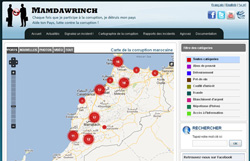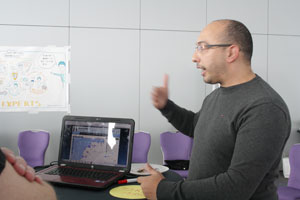There was a general feeling of excitement and optimism about the new role of technology to promote transparency and accountability at the Transparency International SpeakUp! event which I attended in March 2013. There was quite a buzz about online denunciation tools in particular, and different Transparency International chapters are looking into ways to embrace new tools or improve existing ones to encourage citizens to report corruption cases.
 In February 2012, Transparency Morocco launched the online platform Mamdawrinch.com (which means “We will not bribe”). The aim was to provide a tool for anonymous denunciation to encourage people to speak up and discuss corruption in public. Today, corruption is becoming a mainstream topic and even the government claims to be ramping up the fight against corruption. We are considering moving Mamdawrinch’s mission beyond anonymous reporting to enable interaction with legal advice centres and educate the public on empirical cases and practical tools to fight corruption.
In February 2012, Transparency Morocco launched the online platform Mamdawrinch.com (which means “We will not bribe”). The aim was to provide a tool for anonymous denunciation to encourage people to speak up and discuss corruption in public. Today, corruption is becoming a mainstream topic and even the government claims to be ramping up the fight against corruption. We are considering moving Mamdawrinch’s mission beyond anonymous reporting to enable interaction with legal advice centres and educate the public on empirical cases and practical tools to fight corruption.
This blog post shares some of the thoughts exchanged on Transparency Morocco’s online reporting tool.
Technology cannot fight corruption. People can.
An online site is not a solution. It is merely a tool. One cannot iterate this statement enough. Technology can empower citizens, raise awareness and pressure authorities. Yet, technology cannot fight corruption; it cannot change cultures, detect problems, propose solutions or amend laws. People can. As we are building online tools, we should remember their raison d’être: they should be part of a broader strategy of engagement and participation.

The author as he explains the idea behind mamdawrinch.com at a global meeting of over 70 representatives of Transparency International’s legal advice centres around the world.
Measuring success
Closely related to the first point, it is important to set clear objectives to measure the platform’s success. In my opinion, objectives should move beyond statistics on the number of site visits to more functional goals. For example, one could look at the number of online visitors who meet with a legal advisor working with one of Transparency Morocco’s legal advice centres in person, the number of online visitors who pursue legal actions – or even better – the number of successes such as a cancellation of a corrupt tender or the dismissal of a police officer who solicited a bribe.
Responding to corruption – feedback and user interaction
Having a feedback loop is crucial. When citizens report corruption cases, they expect at least a reaction, if not a solution to their problem. This is one of the most difficult challenges to tackle when building a reporting tool. In the case of Mamdawrinch, citizen reports are currently published on the site, pinned on a map and shared on Facebook and Twitter. We are realising that this is not sufficient. Users often ask for guidance or label their experience incorrectly as corruption. The site should also provide documentation and interact with users.
A dedicated team
Technology has a cost. In addition to the cost of technical development, the cost of human resources should not be underestimated. Although there is a plethora of free open source software, a successful online experience requires technical work and it certainly requires human support and follow-up to keep analysing and reacting to the reports. Unlike other timely crowdsourcing efforts like crisis mapping or election monitoring where volunteers contribute their time and skills, fighting corruption is a long-term fight. The energy and the excitement tend to wind down with time. In my opinion, it is important to have professionals who keep building the community, bringing the topic to the spotlight and reacting continuously to current affairs. A high quality follow up requires professional dedication from legal advice centres’ staff.
In the case of Mamdawrinch, we learned the hard way that the site could not function without a dedicated team who provides daily support. Today, Transparency Morocco has a full-time person that manages its online presence, and a dedicated legal advice centre team which receives requests through its hotline and offices in Rabat, Fes and Nador. We are now looking into coupling the work of the legal advice centre and Mamdawrinch so that the internet will be another two-way communication channel for legal advice centres.
Decide on strategy before choosing technology
Cool technology is not necessarily the best. A common mishap is to pick the technology before deciding on the online strategy. Engineers are naturally inclined to prefer cool new technologies but this may not be the right fit for what is needed. Here are two examples of cool technologies that were debated when setting up Mamdawrinch: Geomapping and SMS.
Geomapping has become a buzz word and Ushahidi proved to be a powerful, accessible and mature platform. Yet we realised that geomapping hotspots may not be the best way to visualise corruption. It may even be counterproductive: the use of exact geo-location information can be defamatory and unless it is sustained with solid proof, it could lead to legal action. Also, the lack of incidents reported in a geographic area may be interpreted incorrectly as lack of corruption in that area. We are currently considering adding new visualisations to identify hot sectors and trends.
Another cool technology is the use of SMS. While the technical platform is available and mature, its implementation in Morocco would require a continuous payment to the telecom company and another non-trivial cost from the citizen. High costs from both the development and user side can hinder the widespread use of SMS, but with a 120 per cent phone-to-citizen ratio, it is definitely worth exploring.
Working with online leaders
Use social media and build online leaders. If we take Morocco as an example, many young people spend hours per day on social media sites. In this space, we are witnessing the emergence of new types of leaders: online leaders. People who believe in the cause and voluntarily promote the fight. Kudos to people like Layla Barrit, Rachid Adil and Selma Sabaa who are spontaneously raising awareness about transparency using social media and setting examples for other young people. This is an area that deserves more innovation. In 2011, social media users organised popular protests against corruption. This powerful energy should be supported to continue the struggle for transparency and accountability. Continuous improvement. There is no magic solution that can be successfully replicated. If we knew how to efficiently fight corruption, we would have already done so. We should promote innovation and risk-taking to come up with new alternatives. In the software development industry, the ‘Agile Software Development’ methodology is often recommended for problems with changing requirements. Corruption is a perfect example of a shifting field where as soon as we find an antivirus, the virus evolves and a new antivirus needs to be invented to fight it.
I am hopeful that technology will result in systemic change and strengthen transparency and accountability. With the growing use of IT by the government and all sectors, transparency measures will become embedded in the system.
Do you run an online reporting platform or have experience using one? What ideas for improvement do you have?















 Connect with us on Facebook
Connect with us on Facebook Follow us on Twitter
Follow us on Twitter